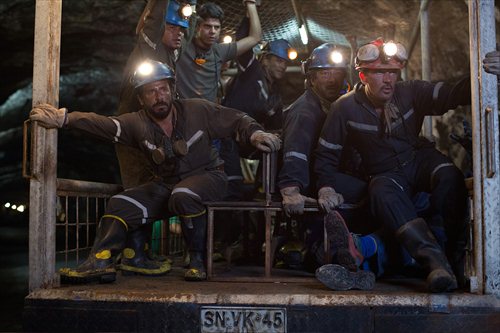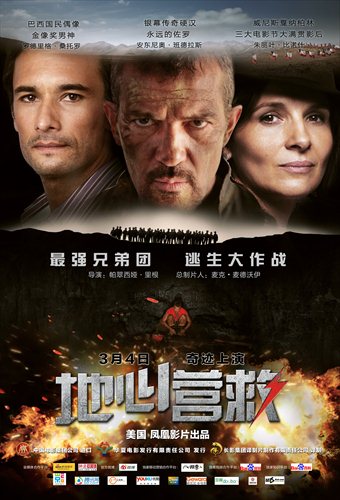Digging up the drama
Miraculous mine rescue becomes a film of great compassion and excitement
Every country and every era have great survivor stories and it's obvious why surviving is a great source of plots for mainstream films - they prove the existence of courage, strength and faith against unimaginable circumstances and harrowing experiences.
I was one of the many people following the Chilean mine collapse in 2010. Six years later there is The 33, director Patricia Riggen's account of the 33 trapped men's two-month ordeal some 700 meters beneath the surface.
In general the film plays it safe and follows the genre formula right from the start, depicting the simple and merry, though far from careless life of mine workers, having a weekend meal with their families, before contrasting it with the horrific incident on the following day that changed everything.
The cinematography is excellent as it follows the vehicle carrying 33 men - 32 miners including the strong-minded leader Mario Sepulveda (Antonio Banderas) and the calm shift supervisor Don Lucho (Lou Diamond Phillips), and a priest - into the mine's only entrance and exit, the light growing dimmer and dimmer before finally disappearing.

A scene featuring Antonio Banderas (right) as the miner leader Mario of The 33 Photos: CFP
Nerve-racking collapse
It condenses the hour-long ride through the meandering burrows and deep into the mountain into a well-cut 1-minute scene that feels amazingly real - in a split second or two we could be one of them on the shaky vehicle, amid rising temperatures.
The collapse of the mine, which follows, is to-the-point, nerve-racking and technically satisfying - thanks to fine CGI work.
The real story unfolds as the 33 men enter a rescue chamber where the canned food and water stored was planned to last only three days.
The replaying of the genre formula continues, as the film pictures one hiccup after another, false hopes and minor conflicts sandwiched in between.
However, it all holds together. The film does a particularly good job as it meticulously describes how the men stretch their days by dividing the food supply to an extremely meager portion every day until, eventually, they come to their last meal.
This last meal stands out from this documentary-style treatment till then, for this, in contrast is boldly fantastical - each of these despairing men, holding barely a mouthful of canned tuna-flavored water, suddenly begins to picture their loved ones bringing in their favorite dishes and joining them in a feast.
More pain and sorrow
It is an exuberant and glowing scene, but somehow it manages to evoke even more pain and sorrow.
The despair underground is reflected by the sadness and anxiety above ground, as the family members of the trapped ones camp at the mine and push Chile's Minister of Mining, a young and suave Laurence Golborne (Rodrigo Santoro), to launch a serious rescue effort.
The key here lies with vendor Maria Segovia (Juliette Binoche), the sister of one of the trapped 33.
This solid-as-ever actress is initially persuasive but the script, which mostly sees her hotly defying and confronting Golborne and later forming a friendly, understanding bond with him, feels rather contrived.
Director Riggen adds a strong authenticity above ground, as she uses real footage of news reports - BBC and CNN among them - to explain the rescue development.
Binoche might be just one of the international cast that offers a good performance in the film, but for me the best has to be the Philippines-born American actor and director Lou Diamond Phillips, who plays the supervisor.
He manages to make the character's many layers comprehensible - be it indispensable guilt, as he is responsible for the miners' safety, heartbroken disillusionment with the irresponsible mine owner, or sensitivity and gentleness, as he encourages and soothes his companions through the difficulties, in a way quite different from the more straightforward, charismatic leader, "Super Mario."
As the last of the 33 to be transported to safety, he delivers the film's most touching moment - he looks for the last time at the giant rocks where Mario inscribed "33 miners survived here - God was with us," bursts into tears and puts a fist into his mouth to stop himself crying out loud, before walking to be rescued.
Some critics have noted that the film leaves most of its 33 title characters to one side, letting the focus fall on Mario Sepulveda, as well as a few others because of their seniority, national identity, or personality, something that reinforced the media hype that selectively surrounded them right from the moment they were found to be still alive underground.
That is true, and the 33 people indeed seem to be reduced to a few stereotypes at times, but a more egalitarian, complete and authoritative account is perhaps a little too much to ask from a 127-minute film.
The best part of the film has to be its very end, where the real 33 miners are seen enjoying themselves on a beach - big smiles all-round.
I was not smiling but shocked to learn the mine owner was found not guilty of an offence and none of the miners received any compensation for their ordeal.
But, as the credits say at the end: "To this day they live as brothers."
This is a film with great compassion and one to respect.

A poster for the film
Everyone's a critic
GT: How much did you know about the real-life event and how does the film reflect your memories of that?
Diana, 29, design
"It was the biggest news at that time so I knew it was like a miracle, and I always pictured the surviving miners as some people with unbelievable will and endurance. However, after watching the film, I realize they are more than that - for example, they are very professional, their knowledge of the mountain and geology helped in the eventual rescue."
GT: Whose performances in this new film did you find most impressive?
Lin Zhiguang, 32, marketing
"All the actors were great, but I would say Juliette Binoche because it was unexpected of her. I remember her as an elegant, somewhat mysterious urban woman who encounters first-world problems only, but here she is this worn, unfortunate and fierce vendor and she nails it."